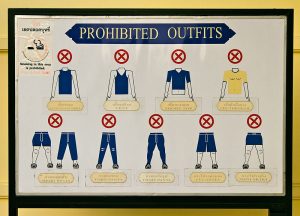
A Randstad survey of 1,200 employees in the US revealed that one-third would not only quit their job—or reject a job offer—if they were required to dress conservatively, not even a $5,000 bump in pay would bring them back. This attitude towards workplace dress codes is becoming global, as more and more companies relax the rules in order to recruit and retain new generations of talent.
Despite most employees saying that their employers’ dress code is business casual (26%), casual (26%), or that there’s no real dress code at all (20%), they still understand the need for decorum when the occasion presents itself. 65%, think it’s important to wear smart clothes to a job interview, regardless of that workplace’s dress code.
You only get one chance to make a good first impression. That might be why 42% of respondents said they’d rather be 20 minutes late to a job interview than arrive looking dishevelled, sweaty, or underdressed. Even those interviewing by video see the need for a smart appearance with 50% wearing business on the top and casual on the bottom. Their interviewer is none the wiser.
There is such a thing as too casual. This is where employees draw the line:
- Ripped jeans (73%), and their cousin, leggings (56%) are not considered appropriate workwear, yet they creep into the office again and again
- Sky-high heels (defined as heels over three inches) are deemed ‘unprofessional’ with 40% saying the same about open-toed shoes.
- Young people are the worst offenders. Around 38% of employees between 25 and 35-years-old admit they’ve been asked to dress more professionally by their manager, or called into HR over their clothing.
Traci Fiatte, CEO, non-technical staffing, Randstad US, explained, “There’s an interesting disconnect around younger workers. Most associate dressing up with more confidence and better work performance, but nearly 40% also report they’ve had a manager speak to them about dressing more professionally.”
Fiatte concluded, “The bottom line is, as long as employees dress in a way that’s consistent with their employer’s policies, most managers are less interested in what their employees wear than about their performance and work output.”
While that is an admirable sentiment, there can be problems if there is no dress code at all. 30% of workers experience anxiety and uncertainty over what to wear due to an employer’s unclear dress code. If workers continue to feel uncomfortable, or perhaps even stressed, due to the lack of clarity then this could lead to deterioration of the overall workplace culture. This could be avoided with a simple yet clear set of guidelines around what is acceptable workwear.
Whatever rules a company chooses to adopt over appearance, it seems that it is more effective to err on the side of casual. 33% of those surveyed said that they would rather quit their job than follow a strict, conservative dress code. 41% of those workers already in an environment with a strict dress code would prefer to have those relaxed instead of a small pay increase. The importance of casual clothing in modern workplaces cannot be over-stressed.
Overall, while casual dress is overwhelmingly favoured by today’s workers, it does not equate to throwing away the rulebook entirely. Workers are still more comfortable when there are guidelines in place and parameters to stay within. Given the importance that current generations place on positive work culture, it is crucial that employees create a concensus around what their employees want alongside what they collectively feel is acceptable. Once that is achieved, workers can get back to focusing on their job and not on another avoidable complaint.





